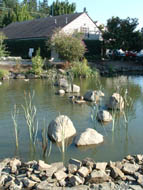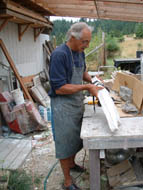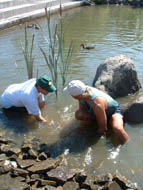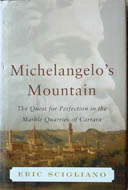- Details
-
Created: Thursday, 02 March 2006 06:47
In the past you have requested ideas for articles, so I am submitting this in the hope that the membership will enjoy reading the results of my Millennium Plaza waterfront commission experience in Lake Oswego, completed in September of 2005.
This opportunity was truly a 3 ring circus. The river boulders were found, assembled, numbered, and put into the 45 foot long grouping illustrated in the photograph at the stone yard - two hours from my studio and a half hour from the final site. Meanwhile, the 30 bronze castings which would be placed among these boulders were produced over several months in my studio and through the foundry in Eugene. Finally, on the fateful morning of installation, as the numbered boulders arrived on trucks, I appeared with the bronzes and stainless steel pins. The crane then lifted the 44 tons of stone, putting it into the murky 3 ½ feet of water, 12 feet from the steps of the plaza. I have never pulled the threads of a commission together from such far flung locations. It was an exercise in courage - pure and simple.
This “naturescape” was intended to be not just visual art, but a barrier to keep unauthorized boats from using the plaza steps as access to the lake. The rocks and 5 foot vertical, bronze cattails became a natural fence. Individual rock placement was important and the whole grouping had to look good not only in 3 ½ feet of water but also in the much lower water level during the dry season. The attachments for the 30 bronzes also had to look natural at all water levels. My design mind was filled with unknowns.
In truth, I am amazed how the obstacles melted away once I committed to the project. This artwork had more parts and larger size by far than any I’ve attempted in the past. I would not see it in its final form until the day of public review. There was anguish, there were doubts. There was a definite timeline, and so many questions! And then, there were unexpected angels, too. The angles made all the difference.
My first angel was the city Redevelopment Manager, who contacted me, encouraged my efforts and accepted my fullest design and highest bid. He facilitated timely payments, expected a successful outcome, and arranged crane service for me at no charge. He even jumped into the water with me to set the bronzes. Secondly, the landscape rock yard owner took my needs seriously, provided the work site, a great price on boulders, and twice provided a man and heavy machinery to move boulders at no cost. Lastly, the crew at the bronze foundry pushed my needs to the top of their busy schedule to ensure timely delivery. Producing the 30 bronzes required me to make 2 original cattail designs and 15 different rubber molds for a total of 320 wax castings. These were then cast in bronze, cleaned, and welded together before coloring. My hands were as tired as they have ever been.
In the end, I was happy with the result, but not completely satisfied. Some boulders broke in transport, and some of the finest rocks ended up missing from the design. This changed the placement of steel pins and bronzes. Due to water depth, only some of the rocks were to show above water level and the loss of several diluted the strength of the design. Yet, the city was satisfied, with their needs fulfilled. I had been pulled, stretched, and brought near to exhaustion and yet I ended by being made stronger. Someho w, somewhere, this effort will lead to another opportunity with Sculpture and will encourage me once again to say, “Yes,” when opportunity calls.
w, somewhere, this effort will lead to another opportunity with Sculpture and will encourage me once again to say, “Yes,” when opportunity calls.
- Details
-
Created: Tuesday, 30 November 1999 00:00
 Local author Eric Scigliano writes a fascinating history and travelogue taking us through yesterday and today in Carrara, the “marble belt” of Italy. His book is truly a biography for stone carvers.
Local author Eric Scigliano writes a fascinating history and travelogue taking us through yesterday and today in Carrara, the “marble belt” of Italy. His book is truly a biography for stone carvers.
Scigliano’s ancestors were skilled carvatori or quarrymen, those who split out and brought down the large blocks of marble from the mountains surrounding Carrara. A carvatori was a respected professional and not considered a common laborer. Scigliano gives us a textured and colorful picture of the culture and character of the area’s inhabitants, their proud and defiant politics as well as their cuisine and love of music. The Carrara of today still maintains some of the character of Michelangelo’s time. However, the area is now all but depleted of statuario, and rivalries between quarries have grown, as has tourism.
Numerous biographies of Michelangelo’s life exist but Scigliano includes biographical material that focuses on his passion and attachment for the marble of Carrara. The marble was often referred to as “living stone,” for its unique potential to generate a living and flesh like quality. Throughout his life Michelangelo spent months at a time in Carrara looking for stone without flaws for his colossal projects. He liked the Carrara area, and liked avoiding some of the pressures and politics related to his commissions. Much has been written about the demands on Michelangelo as the protégé of the Florentine ruling family the Medici and his commissions with the Vatican, most notably with Pope Julius. Scigliano takes us through the details with an easy and modern style.
One of the things that make this book such an enjoyable read is the way the author often segues into interesting tangential supporting material when describing a particular aspect of a subject. For example, while describing stone tools of the period and Michelangelo’s preference for the use of the forked chisel, he refers to a conversation he had with our own Sabah Al-Dhaher. Sabah had explained, “The forked chisel shows you the form. It’s like drawing on the stone. You are drawing in three dimensions.”
The book is quite a ride. You’ll learn a little Italian, about carvatori tools and techniques of the times, psychoanalytic interpretations of Michelangelo, Vermont granite quarry politics, the history of the stone that became the sculpture David, mineralogy, details of the cleaning of the Sistine Chapel ceiling and some of the ideological differences between Michelangelo and Leonardo da Vinci. It contains a little of something for everyone.




 w, somewhere, this effort will lead to another opportunity with Sculpture and will encourage me once again to say, “Yes,” when opportunity calls.
w, somewhere, this effort will lead to another opportunity with Sculpture and will encourage me once again to say, “Yes,” when opportunity calls. Local author Eric Scigliano writes a fascinating history and travelogue taking us through yesterday and today in Carrara, the “marble belt” of Italy. His book is truly a biography for stone carvers.
Local author Eric Scigliano writes a fascinating history and travelogue taking us through yesterday and today in Carrara, the “marble belt” of Italy. His book is truly a biography for stone carvers.